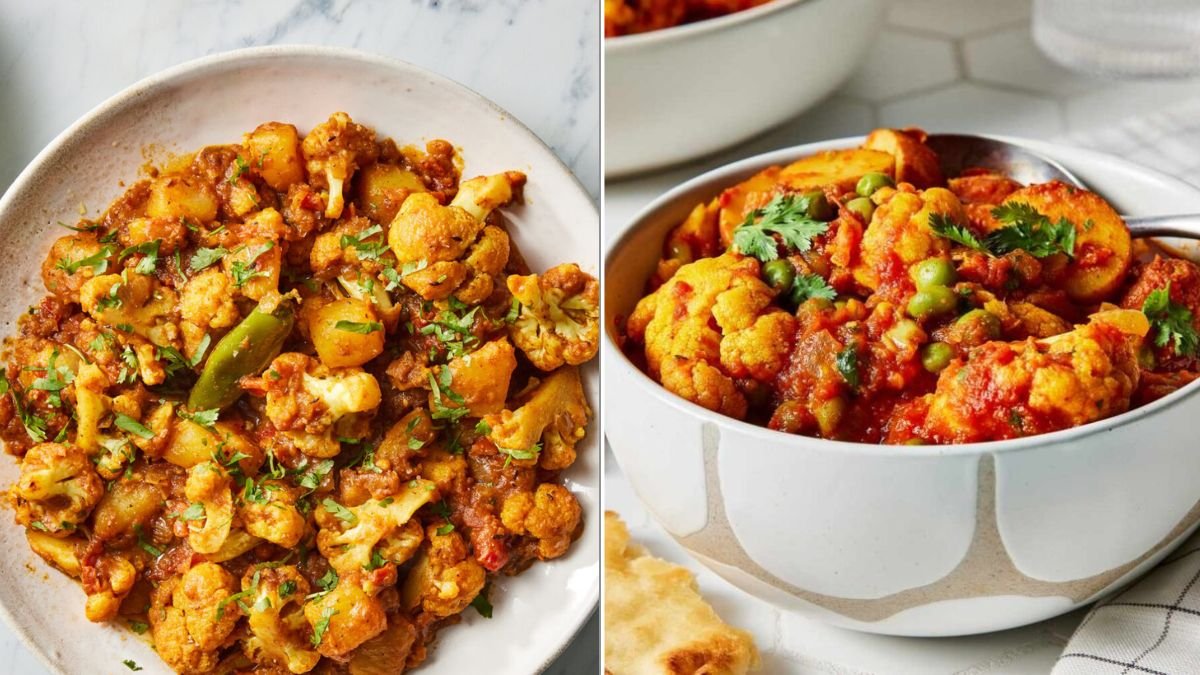Few dishes represent the heart of Indian home cooking quite like Aloo Gobi — a comforting, earthy combination of potatoes (aloo) and cauliflower (gobi), cooked with aromatic spices and love. Whether served with warm rotis, parathas, or steamed rice, this simple yet deeply flavorful curry embodies the soul of traditional Indian cuisine.
The beauty of Aloo Gobi lies in its simplicity — it requires no fancy ingredients, just a perfect balance of spices and technique. When cooked right, the cauliflower stays tender yet crisp, the potatoes soak up all the flavors, and every bite bursts with the warmth of Indian spices like turmeric, cumin, and garam masala.
If you’ve ever wondered how to achieve that authentic restaurant-style Aloo Gobi — perfectly spiced, non-mushy, and aromatic — this guide is for you. Follow these 6 simple steps to master the art of cooking this beloved vegetarian dish at home.
Step 1: Gather Fresh Ingredients and Spices
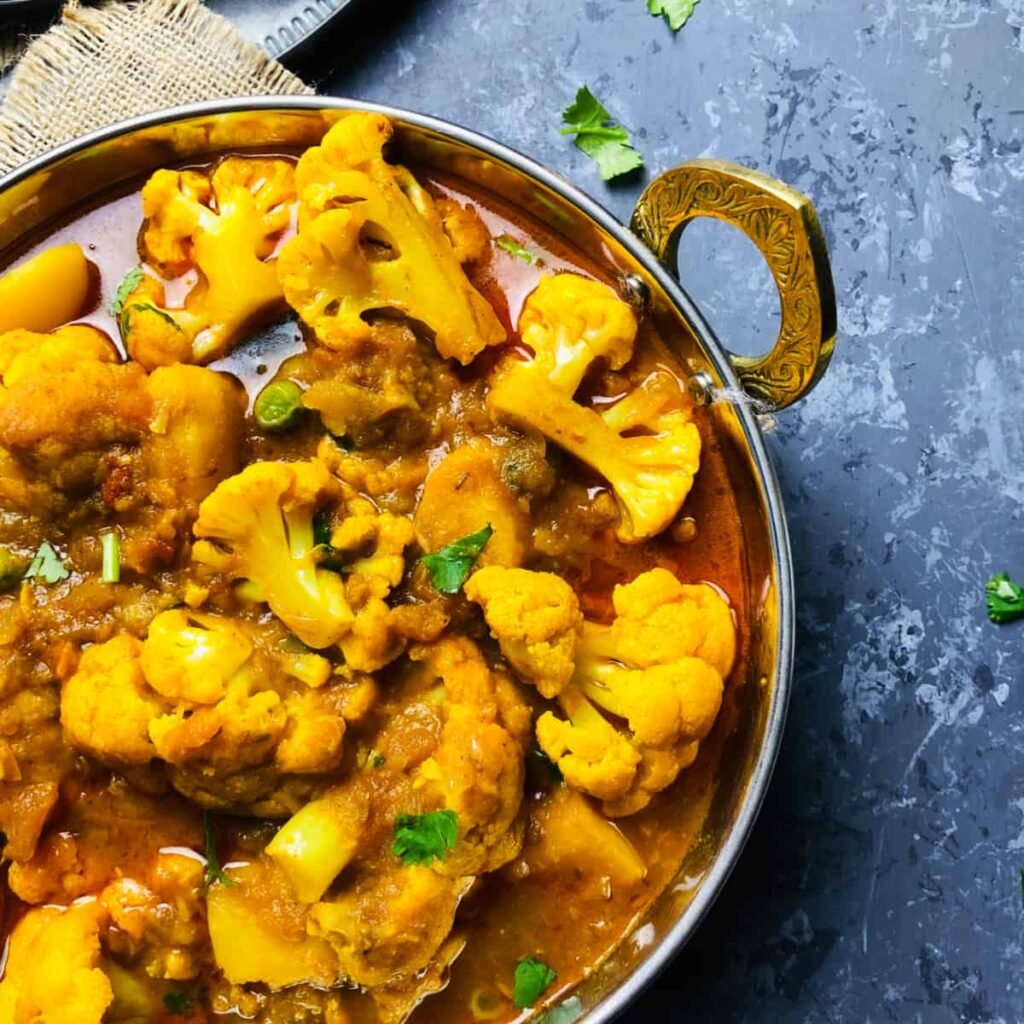
Before you begin, make sure all your ingredients are ready. Aloo Gobi cooks quickly once started, so preparation is key.
Main Ingredients:
- Cauliflower (Gobi) – 1 medium head, cut into medium florets
- Potatoes (Aloo) – 2 medium, peeled and diced
- Onion – 1 large, finely chopped
- Tomatoes – 2 medium, finely chopped (or puréed for smoother texture)
- Green Chilies – 1 or 2, slit
- Ginger-Garlic Paste – 1 tablespoon
- Oil or Ghee – 3 tablespoons
- Salt – to taste
- Fresh Coriander Leaves – 2 tablespoons, chopped (for garnish)
- Lemon Juice – 1 tablespoon (optional, for freshness)
Spices:
- Cumin Seeds (Jeera) – 1 teaspoon
- Turmeric Powder (Haldi) – ½ teaspoon
- Red Chili Powder – ½ teaspoon (adjust to taste)
- Coriander Powder – 1½ teaspoons
- Cumin Powder – 1 teaspoon
- Garam Masala – ½ teaspoon
- Dry Mango Powder (Amchur) – ½ teaspoon (optional for tanginess)
Pro Tip: Always use fresh cauliflower — older florets tend to turn mushy and watery. If your cauliflower has small insects (common in organic produce), soak the florets in warm salted water for 10 minutes before cooking.
Step 2: Prepare and Parboil the Vegetables
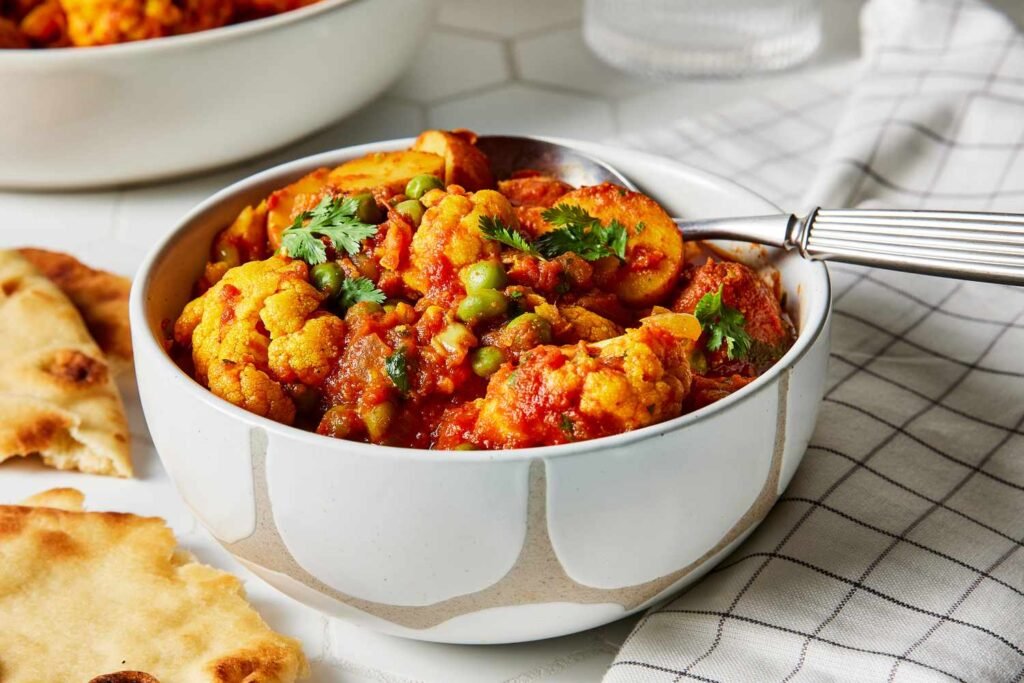
To prevent your Aloo Gobi from turning soggy, parboil the cauliflower and potatoes before cooking. This ensures even cooking and helps the vegetables hold their shape.
- Boil water in a pot with a pinch of salt and turmeric.
- Add cauliflower florets and diced potatoes.
- Blanch for 3–4 minutes, just until slightly tender.
- Drain immediately and set aside.
Alternatively, you can pan-fry them in a little oil until golden and partially cooked — this method adds extra flavor and texture.
Why Parboiling Helps:
- Prevents cauliflower from getting mushy.
- Reduces cooking time.
- Ensures the spices coat evenly.
Pro Tip: Dry the vegetables after parboiling with a paper towel — excess moisture can make the curry watery.
Step 3: Build the Flavor Base (Masala Preparation)
This is where the magic happens — the aromatic tempering and spice base that gives Aloo Gobi its signature depth of flavor.
- Heat 3 tablespoons of oil or ghee in a heavy-bottomed pan or kadhai.
- Add cumin seeds and let them crackle for a few seconds.
- Add chopped onions and sauté on medium heat until they turn golden brown — this forms the base flavor of the curry.
- Add ginger-garlic paste and green chilies. Sauté for 30 seconds until the raw smell disappears.
- Add chopped tomatoes and cook until they turn soft and oil starts separating from the sides.
Now, stir in all the dry spices:
- Turmeric powder
- Red chili powder
- Coriander powder
- Cumin powder
- Salt to taste
Cook this mixture for 2–3 minutes, stirring constantly to prevent burning.
Pro Tip: If the masala starts sticking to the pan, sprinkle a few drops of water — this helps the spices cook evenly and intensify flavor.
Step 4: Add the Vegetables and Cook Gently
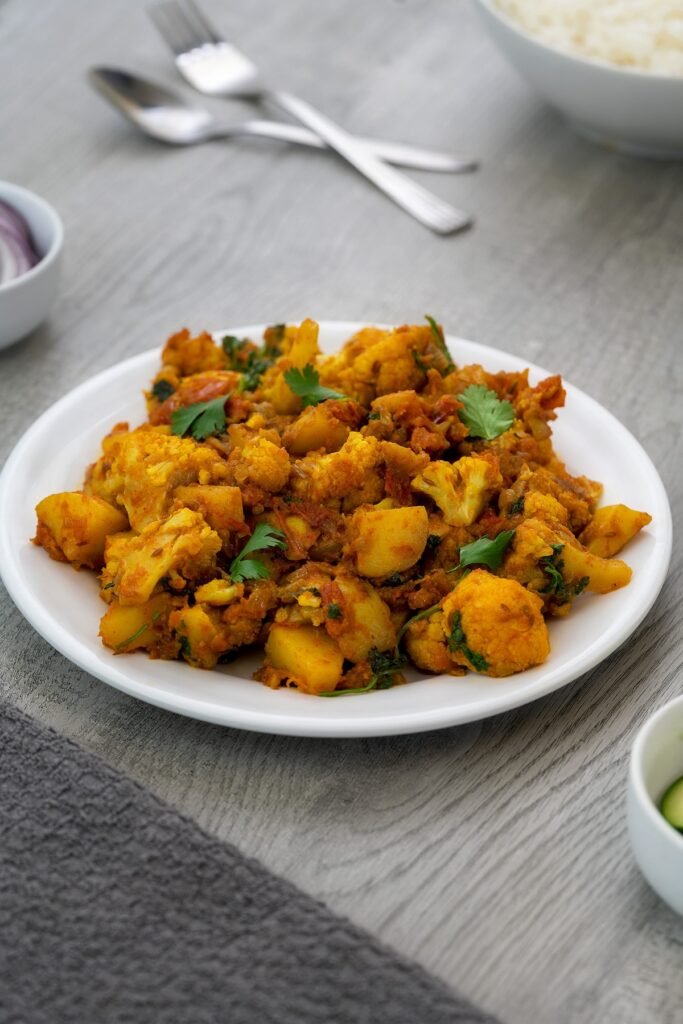
Now it’s time to bring the dish together.
- Add the parboiled potatoes and cauliflower to the masala.
- Stir gently to coat every piece evenly with the spice mixture.
- Cover the pan with a lid and cook on low to medium heat for 10–12 minutes, stirring occasionally.
Avoid adding too much water — Aloo Gobi should be semi-dry, not runny. If needed, add just 2–3 tablespoons of water to prevent burning.
The steam inside the covered pan will help the vegetables cook perfectly without losing texture.
Pro Tip: Stir gently — cauliflower florets can break easily when overmixed. Use a flat spatula and fold the masala instead of stirring vigorously.
Step 5: Add the Finishing Touches
Once the vegetables are cooked and tender, it’s time to elevate the flavor with a few final touches.
- Sprinkle garam masala and amchur powder (or squeeze in lemon juice) for a burst of tang and aroma.
- Mix gently and let the dish simmer uncovered for 2–3 minutes to allow excess moisture to evaporate.
- Taste and adjust seasoning — add a pinch of salt or chili powder if needed.
At this stage, your kitchen will be filled with the irresistible aroma of spices — that’s your cue that Aloo Gobi is ready!
Pro Tip: For an extra layer of flavor, drizzle ½ teaspoon of ghee at the end and mix — it gives the dish a restaurant-style richness.
Step 6: Garnish and Serve Hot
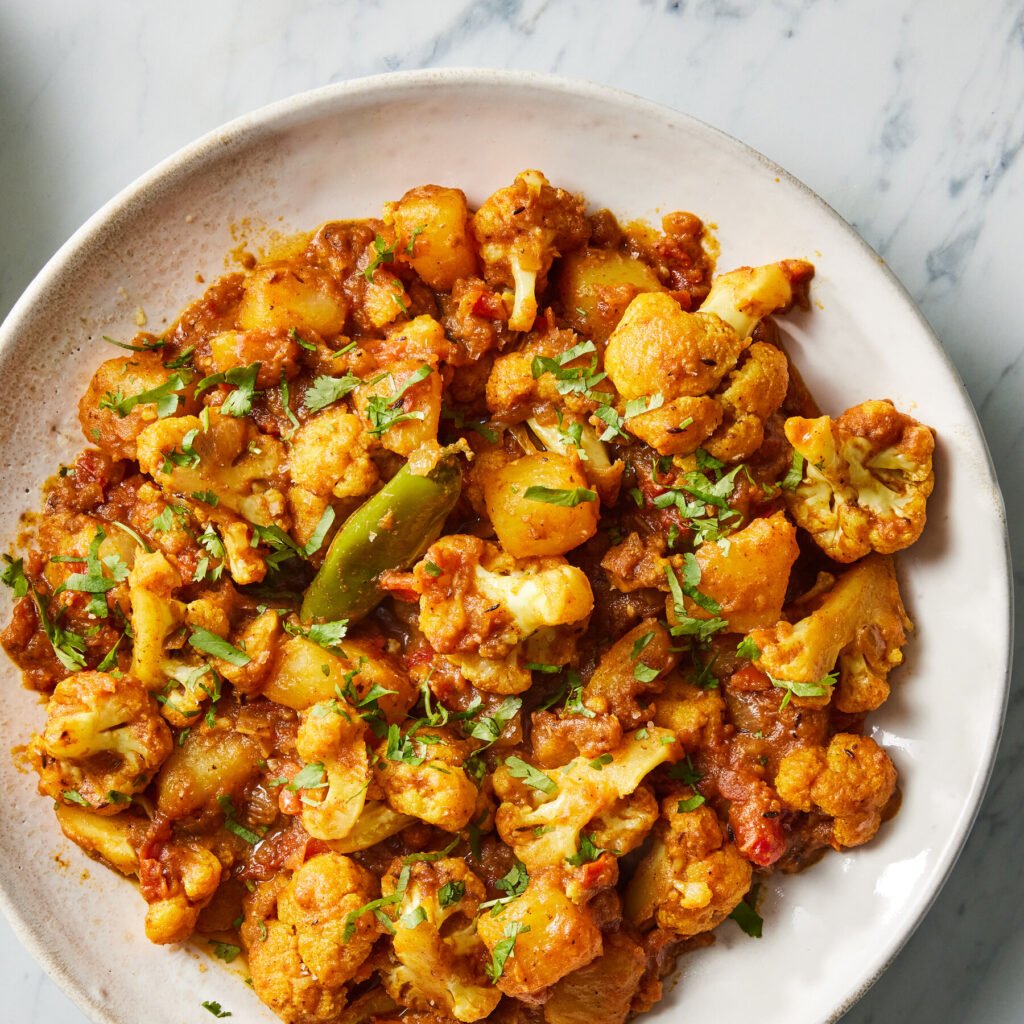
Finally, finish your Aloo Gobi beautifully:
- Sprinkle freshly chopped coriander leaves on top.
- Optionally, squeeze a bit of lemon juice for brightness.
- Serve immediately while hot.
Serving Suggestions:
- Pair with chapati, phulka, or paratha for a traditional Indian meal.
- Serve with steamed basmati rice and dal for a wholesome thali-style lunch.
- For extra indulgence, accompany it with raita or pickle.
Pro Tip: Aloo Gobi tastes even better after resting for 30 minutes — the spices soak deeper, enhancing the flavor. It’s also a perfect make-ahead dish for lunchboxes or meal prep.
Expert Tips for Perfect Aloo Gobi
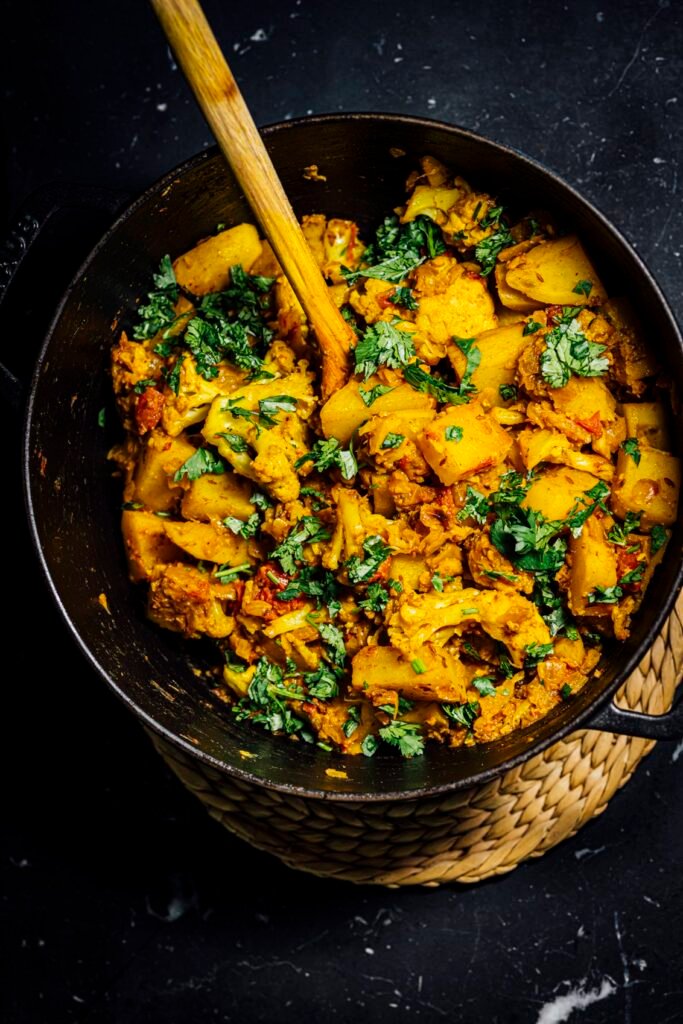
- Roast, Don’t Boil: Parboil lightly or roast the veggies for the perfect texture — mushy cauliflower ruins the dish.
- Use Fresh Spices: Freshly ground cumin and coriander elevate the aroma and authenticity.
- Cook Covered First, Then Uncovered: This helps retain softness while allowing excess moisture to evaporate.
- Customize Heat Levels: Adjust chili powder or green chilies to your liking.
- Add Peas or Kasuri Methi: A handful of green peas or crushed dried fenugreek leaves (kasuri methi) enhances flavor beautifully.
- Oil Separation Test: The dish is perfectly cooked when you see a thin layer of oil release from the sides.
Why Aloo Gobi Is a Timeless Classic
- Simple Ingredients: Made from everyday pantry staples.
- Balanced Nutrition: A good source of fiber, vitamin C, and potassium.
- Customizable: Works as a dry curry, semi-gravy, or even oven-roasted version.
- Vegan & Gluten-Free: Naturally fits most dietary preferences.
- Deeply Comforting: Perfect for family dinners, festive spreads, or weeknight meals.
Aloo Gobi isn’t just a dish — it’s nostalgia in every bite. It’s what you find simmering in Indian kitchens on lazy Sundays or lovingly packed in tiffins across generations. The humble combination of cauliflower and potatoes transforms into something extraordinary when seasoned with the right touch of spices and care.
Final Thoughts
Cooking authentic Aloo Gobi is all about balance — between texture, spice, and aroma. You don’t need a dozen complex steps or expensive ingredients, just attention to detail and patience.
Follow this 6-step guide, and you’ll have a dish that’s:
- Fragrant with cumin and turmeric,
- Golden and perfectly roasted,
- Balanced in heat and tang, and
- Bursting with traditional North Indian flavors.
So next time you crave something comforting yet flavorful, skip takeout and make Aloo Gobi at home. With every bite, you’ll taste not just the spices but the timeless tradition of Indian cooking — simple, soulful, and utterly satisfying.
